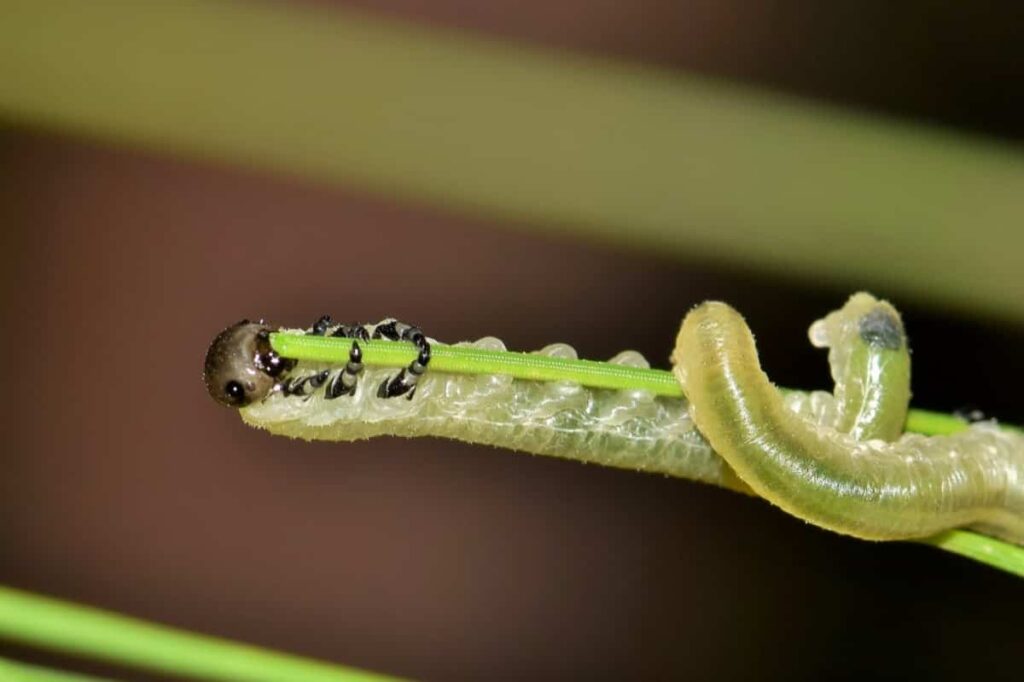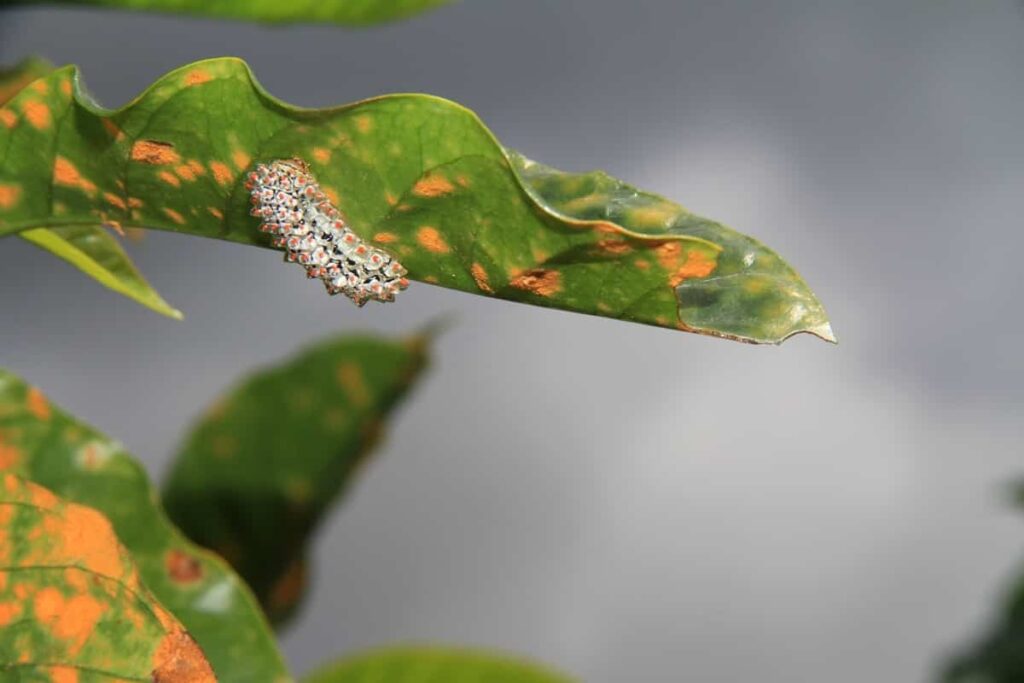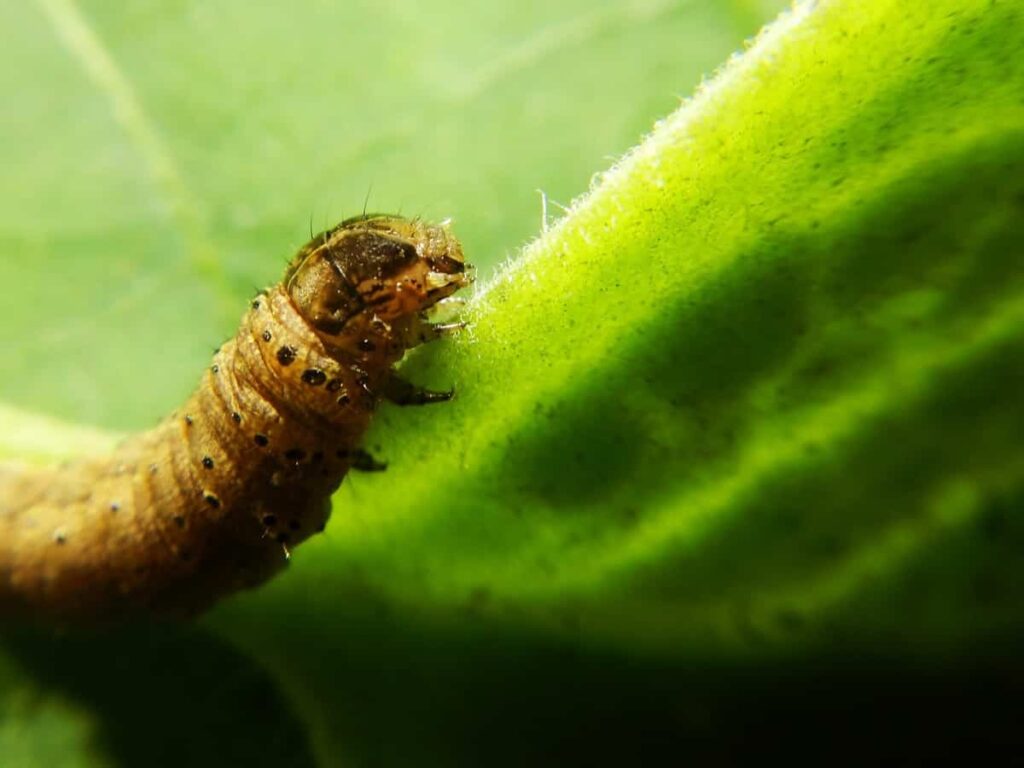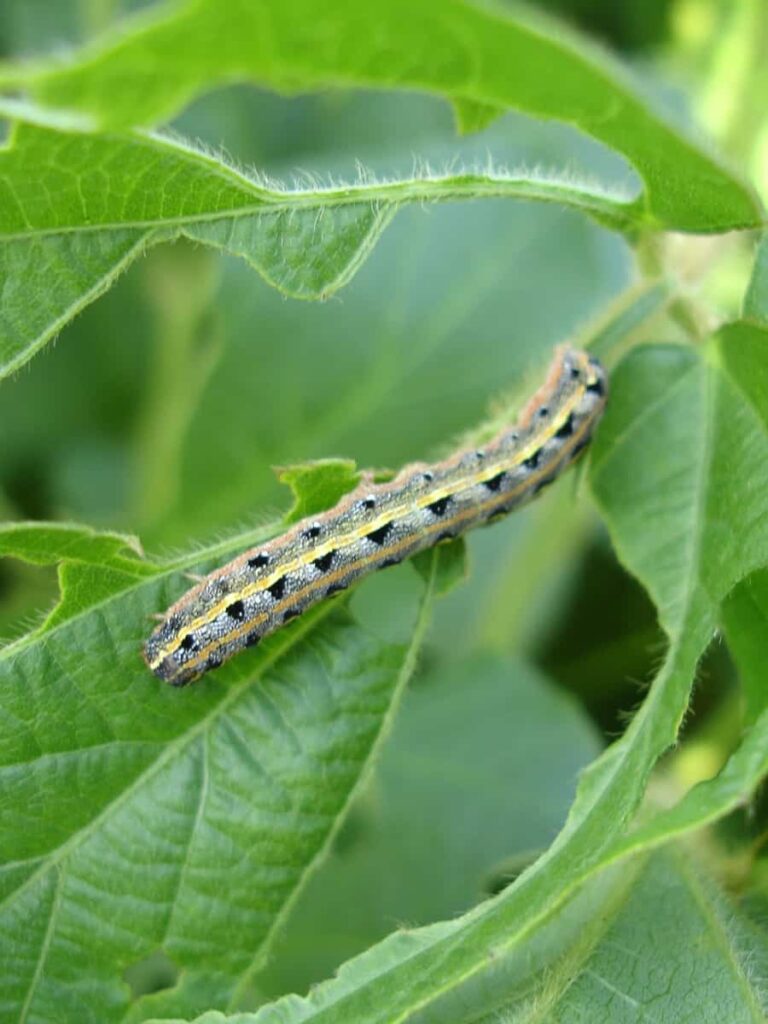Fall armyworm (Spodoptera frugiperda) is a destructive pest of maize, sorghum, rice, cotton, vegetables, and other crops. The caterpillars are highly mobile and can quickly destroy large areas of crops. Fall armyworm has been a problem in Africa for many years, but in 2016 the pest spread to Asia, where it has caused damage to crops in India, Pakistan, Sri Lanka, Nepal, and Bangladesh.

The pest is difficult to control because it can rapidly develop pesticide resistance. Integrated pest management (IPM) strategies are therefore essential for its management. This article will provide Fall armyworm, identify it, and manage it using IPM principles.
How to identify and manage Fall Armyworm
What is a Fall armyworm?
The fall armyworm is a highly mobile caterpillar that can travel long distances in search of food. Its name comes from its habit of migrating in large numbers from the southern United States to the northern United States and Canada in late summer and early Fall. The fall armyworm caterpillar is a voracious eater and can quickly strip a field of corn, sorghum, or another grass crop. The caterpillars are dark green or brown with light-colored stripes running lengthwise down their bodies.
They can grow up to 2 inches long and are often found in groups. If you suspect your crop has been infested with fall armyworms, it is important to take action immediately. The sooner you remove the caterpillars from the plants, the less damage they will cause. Several insecticides are available that will kill fall armyworms, but you may need to reapply them every few days to keep the population under control.
Which crops are affected by Fall armyworm?
Several crops can be affected by Fall armyworms, including maize, sorghum, rice, cotton, and various vegetables. The Fall armyworm’s larvae feed on the plant’s leaves, which can lead to extensive damage. In some cases, the larvae may bore into the plant’s stem. This can cause the plant to wilt and die.
Causes of Fall armyworm spread
The Fall armyworm is a highly destructive pest of maize and other crops. It is native to the Americas but has spread to Africa, Asia, and Australia. The Fall armyworm moth can fly long distances and lay its eggs in various crops. The caterpillars that hatch from these eggs are voracious eaters and can quickly destroy a crop. There are several reasons why the Fall armyworm has been able to spread so rapidly around the world.
First, the Fall armyworm moth can fly long distances, up to 1,000 kilometers (620 miles) in a single night. This allows the pests to travel from one infested area to another quickly. Second, the Fall armyworm caterpillars can feed on more than 80 different types of plants. This means that they can find food almost anywhere they go. Third, the fall armyworm caterpillars are very resistant to insecticides.
In case you missed it: Pest and Disease Management in Kiwi: Causes, Symptoms, Treatment, Chemical, and Biological Control
This makes them difficult to control once they have infested a crop. Finally, the Fall armyworm reproduces very quickly. A female moth can lay up to 2,000 eggs, and each egg hatches into a voracious caterpillar ready to eat. The Fall armyworm has wreaked havoc on crops worldwide since it was first discovered in Africa in 2016. It has spread to over 30 countries on three continents and caused billions of dollars in damage.
How to identify Fall armyworms in your field crop?
If you think you may have found Fall armyworm in your field crop, there are a few ways to identify it. First, check for signs of damage to the crop. This may include chewed leaves or stems or holes in the leaves. Second, look for adult moths. These are brownish and have a wingspan of about 1 inch. The caterpillars are also brownish and can grow up to 2 inches long.
If you see either of these stages of the pest, you likely have Fall armyworm present in your crop. To confirm that you have a Fall armyworm, you can send a sample of the insects or damaged plant material to your local extension office for identification. Once you know that Fall armyworm is present, you can take steps to manage it.
How do you distinguish a Fall armyworm?
The Fall armyworm is a highly destructive pest of maize, rice, sorghum, and other crops. However, it isn’t easy to distinguish from other armyworms because of its variable appearance. The adult moth is brown or gray with dark markings on the wings. The caterpillars are greenish-brown, with light and dark stripes running along the body. They can grow up to 2.5 cm in length. The Fall armyworm is most active during the late fall and summer months. During this time, they lay their eggs on the leaves of host plants.
The eggs hatch into caterpillars and then feed on the leaves for 2-3 weeks before pupating into adults. The adults then mate and lay more eggs, starting the cycle again. The best way to control Fall armyworms is to prevent them from getting established in your crop in the first place. This can be done by scouting your field regularly and removing any egg masses or caterpillars you find. If you find an infestation, several insecticides can be used to control them.
What is the biological control of the Fall armyworm?
The Fall armyworm is a destructive pest of maize and other crops. The adult moth is brown or black with yellow markings and has a wingspan of up to 4 cm. The caterpillars are green or brown with dark stripes running along their bodies. They can grow up to 5 cm in length. The Fall armyworm is native to the USA in tropical and subtropical regions. However, it has now spread to Africa, Asia, Australia, and Europe.
In Africa, the Fall armyworm has become a major pest of maize, causing yields to decrease by up to 30%. There are several methods of controlling the Fall armyworm, including biological control. Biological control involves using natural enemies of the Fall armyworm to help reduce its population. One example of a biological control agent is the parasitic wasp (Trichogramma spp.). This wasp lays its eggs inside the eggs of the Fall armyworm.
When the wasp larvae hatch, they eat the contents of the Fall armyworm egg, killing it before it has a chance to develop into a caterpillar. Another example of a biological control agent is the entomopathogenic fungus (Beauveria bassiana). This fungus infects and kills caterpillars when they come into contact with it. It can be applied as a spray on crops or onto bait stations that attract caterpillars.
Fall armyworm nature of damage in crops
Fall armyworm larvae are highly destructive to crops, causing extensive damage by feeding on leaves, stems, flowers, and fruits. The larval stage is when the fall armyworm does the most damage to crops. The adult moth is much less damaging to crops. However, the fall armyworm has a voracious appetite and can quickly destroy a crop if left unchecked. The fall armyworm’s destructive nature has made it the most devastating pest of agriculture worldwide.
In case you missed it: How to Start Pig Farming in Cambodia: Business Plan, Breeds, Cost, Profit, and Management
The fall armyworm is native to North America in temperate regions but has spread to tropical and subtropical regions worldwide through human activity. As a result, the fall armyworm is now found in nearly every country where corn is grown. Larvae typically go through 5 stages of growth before pupating into adults. Each stage lasts about 7 days, which can vary depending on temperature and food availability. Once fully grown, larvae leave the plant to find a suitable place to pupate into adults.
How does Fall armyworm spread?
Fall armyworm spreads rapidly throughout a field, consuming all the available leaves. The larvae can travel long distances by hitching rides on wind currents or in vehicles. They also spread by crawling through fields and laying eggs on new plants.
What do Fall armyworm moths do to your crops?
Fall armyworm moths are attracted to lights and may lay their eggs on nearby crops. The caterpillars that hatch from these eggs will then feed on the leaves of the crops, causing damage. In addition, fall armyworm moths can also transmit diseases to crops.
How do you ascertain the larva feeding your field crop is a Fall armyworm (FAW)?
To ascertain that the larva feeding your field crop is a Fall armyworm (FAW), you must first identify the presence of this pest in your area. You can monitor local media reports and contact your state Extension office. If FAW has been reported in your area, inspect your crops regularly for signs of infestation. Early detection is key to managing any infestation, and with FAW, you should look for small, green caterpillars with a light stripe running down their backs.
These caterpillars are often found on the underside of leaves, feeding on the leaf tissue. As they feed, they create small, ragged holes in the leaves. If left unchecked, an infestation of FAW can quickly defoliate a plant. If you suspect that your crop has been infested with FAW, you can take a few steps to confirm it. First, check for egg masses on the undersides of the leaves; these masses are creamy white and roughly spherical.
In case you missed it: How to Start an Organic Farming in Andhra Pradesh: Crops, Weed Management, Nutrients, Pest, and Disease Management
Second, look for frass (caterpillar droppings) near feeding sites; frass is dark green or black and composed primarily of chewed-up plant material. Finally, look for silken webs near feeding sites; caterpillars produce them as they move from leaf to leaf, and they can often be found on the undersides or at leaf margins.
What are the symptoms of Fall armyworm damage in crops?
Fall armyworm damage in crops can vary depending on the stage of infestation but typically includes wilted or dying plants, holes in leaves, and excessive leaf feeding. In more severe cases, entire plants may be killed. Fall armyworm damage is often most evident on the edges of fields or areas with less wind or insecticide protection.
Chemical control of Fall armyworm in your crop
The fall armyworm (Spodoptera frugiperda) is a destructive pest of many crops, including corn, sorghum, rice, and soybeans. While several effective chemical control options are available for this pest, it is important to correctly identify the fall armyworm in your crop to choose the most appropriate treatment. The fall armyworm has a voracious appetite and can cause significant damage to crops in a very short period.
The caterpillars can skeletonize leaves, which can severely reduce the photosynthetic area of the plant and lead to yield loss. In addition, the caterpillars can bore into stalks and stems, causing further damage. Several different chemical options are available for controlling fall armyworms, including insecticides such as pyrethroids and carbamates. It is important to correctly identify the fall armyworm before choosing a treatment option, as some insecticides may be more effective against certain life stages than others.
For example, foliar treatments with pyrethroids are most effective against young caterpillars, while carbamate insecticides are most effective against older caterpillars. Additionally, it is important to consider the timing of your chemical application. Fall armyworms typically move from one field to another in search of food, so it is important to treat infested fields early to prevent further spread.
Management practices to prevent control and treat Fall armyworm in your crop
Fall armyworm management practices should be aimed at preventing, controlling, and treating the pest in your crop. A combination of cultural, biological, and chemical control methods may be needed to manage Fall armyworm populations effectively. Cultural control methods include early planting, crop rotation, residue management, and traps.
In addition, biological control agents such as parasitic wasps can help to reduce Fall armyworm populations. Chemical control options include insecticides and Bacillus thuringiensis (Bt) toxins. Fall armyworm larvae are most susceptible to control measures during the early stages of development. Therefore, it is important to monitor your crops regularly for signs of infestation and take action as soon as possible if larvae are present.
How to control Fall armyworm organically?
A few organic methods can be used to control Fall armyworms. One is to encourage natural predators of the fall armyworm, such as parasitic wasps, to take up residence in your field. Another is to use Bacillus thuringiensis (Bt), a naturally-occurring soil bacterium, as a biological insecticide.
Bt produces a toxic protein for caterpillars but poses no threat to humans or other animals. Finally, you can also try physical barriers such as fences or nets to keep the pests from getting to your crops in the first place.
Do Fall armyworm attacks Greenhouse crops?
Fall armyworm can be a serious problem for greenhouse crops, causing extensive damage to leaves, buds, and fruit. The best way to protect your crops is to identify the pest and take steps to control it.A fall armyworm is a type of caterpillar that feeds on various plants. The larvae are small and green, with black stripes running along their sides. They are typically 1-2 inches long when fully grown.
Fall armyworm caterpillars can cause significant damage to greenhouse crops, including tomatoes, peppers, eggplant, and cucumbers. The best way to control fall armyworms is to prevent them from getting into the greenhouse in the first place. Keep your greenhouse clean and free of debris where the pests can hide. Inspect plants before bringing them into the greenhouse, and remove any infested plants immediately.
In case you missed it: Farming Business Plan PDF: for Poultry, Livestock, Agriculture, Horticulture, Greenhouse, and Hydroponic

If you find fall armyworm caterpillars in your greenhouse, there are several ways to get rid of them. Hand-picking is often effective, especially for small infestations. You can also use Bacillus thuringiensis (Bt), an insecticide targeting caterpillars, or other registered pesticides. Follow the instructions carefully on the label to avoid harming non-target insects or plants.
Fall armyworm management in maize crop
Fall armyworm is a damaging pest of maize crops. The larvae feed on the plant leaves, causing extensive damage. The best way to manage this pest is to identify it early and take action to control it. There are some tips important to identify fall armyworm:
- The larvae are small (about 1 cm long), green or brown, with stripes running along their bodies.
- They are typically found feeding in groups on the leaves of the plant.
- The damage they cause appears as small, round holes in the leaves.
If you suspect that your crop has been infested with fall armyworm, there are some points you can do to control it:
- Destroy any egg masses or larvae you find on the plants. This can be mainly done by hand-picking them off or using an insecticide.
- Avoid planting your crop near areas with high fall armyworm populations (such as fields that have recently had soybeans).
- If your crop does become infested, you can use an insecticide to control the population. But, again, be sure to follow all label instructions carefully.
Fall armyworm life cycle
- Eggs: Fall armyworm eggs are laid in small clusters on the leaves of host plants. They are oval in shape and range in color from white to pale green.
- Larvae: The larvae stage is the primary feeding stage of the fall armyworm. Larvae are cream-colored with dark heads and brownish-black spots on their body. They grow to be about 1-1/2 inches long.
- Pupae: Pupae are brownish-black and about 1 inch long. They are typically found in protected areas such as under leaves or soil crevices.
- Adults: Adult fall armyworms are moth-like insects with a wingspan about 1-1/2 inches. They are dark gray or brown, with two distinct yellowish-white stripes running lengthwise down their body.
Why is the Fall armyworm a difficult pest to control?
The Fall armyworm is a difficult pest to control for several reasons. First, the larvae are highly mobile and can quickly spread through a field, consuming large amounts of crop plants. Additionally, the larvae are resistant to many common insecticides, making it difficult to kill them with chemicals. Finally, the adult moths can fly long distances, making it hard to prevent them from reaching and infesting crops.
Cultural practices to prevent Fall armyworm
Several cultural practices can be used to prevent Fall armyworm infestations in crops. One practice is to plant early-maturing varieties of the crop you are growing. This will help to ensure that the crop matures before the Fall armyworm larvae have a chance to feed on it.
Another practice is using an insecticide dressing on the crop seed before planting. This will help to protect the young plants from infestation by Fall armyworm larvae. Finally, it is important to keep the area around the field free of vegetation and debris. This will help to make it less attractive for adult Fall armyworms to lay their eggs in.
In case you missed it: How to Compost Kitchen Waste with Worms: A Guide to Kitchen Vermiculture

Integrated pest management (IPM) for Fall armyworm
Fall armyworm is a highly destructive pest of maize and other crops. IPM involves using cultural, biological, and chemical controls to manage pests. Cultural controls include early planting, crop rotation, destruction of crop residues, and use of resistant varieties. Biological controls involve using natural enemies such as parasitic wasps and predators.
Chemical controls involve the use of insecticides. IPM programs should be tailored to the specific situation and needs of the farmers. Farmers should be trained to identify Fall armyworm larvae and adults, as well as in the different available control measures.
Conclusion
In conclusion, Fall armyworms can wreak havoc on crops if not properly managed. By being able to identify the pest and knowing what kind of damage it can cause, farmers can take steps to protect their crops. Various management strategies can be employed, and the best course of action will likely vary depending on the situation. However, with proper vigilance and management, Fall armyworm does not have to be a problem for crops.
- Budget Friendly Sheep Shed Ideas: Cheap and Low-Cost Tips
- How Much Do Cattle Farmers Make: Revenue Streams in Cattle Farming
- Management Pests and Diseases in Your Cotton Field
- Sheep Farming Business Plan for Beginners
- Aquaponic Farming at Home: A Step-By-Step Guide
- Profitable Village Farming Business Ideas in 2024
- High-Yield Aquaculture: Fast-Growing Fish for Farming
- Effective Fish Pond Construction Techniques for Beginners
- Irrigation and Water Management in Pineapple Farming
- Blossom to Harvest: Mastering Flowering and Pollination in Papaya Farming
- Pig Fattening Essentials: From Selection to Sale for Beginners
- Raising Wagyu Cattle: A Complete Guide for Premium Beef Production
- Soil Types and Their Water Holding Capacity
- Optimizing Irrigation Schedules for Coconut Groves for Enhanced Yield
- Espresso Your Garden: Coffee Grounds for Healthier Acid-Loving Plants
- The Best Soil Mix for Snake Plants: How to Mix Your Own Snake Plant Soil
- Green Thumb Success: Expert Tips for Cultivating Greenhouse Beans All Year Round
- Bloom All Year Round: The Ultimate Guide to Indoor Hyacinth Care
- Eco-Friendly Gardening: How to Make Liquid Fertilizer from Kitchen Waste
- Ultimate Guide to Grow Anise in Pots: Explore Seed Propagation to Harvesting
- Guide to Raising Chester White Pigs: Discover Breed Facts to Growth Management
- Mastering the Elegance: The Ultimate Guide to Weeping Cherry Tree Care, Planting, and Maintenance
- Ultimate Guide to Planting Garlic in Grow Bags: Growing Strategies for Beginners
- How to Fix Spider Plant Leaf-Related Problems: Natural and Organic Remedies
- 10 Reasons Why Your Tulsi Plant is Shedding Leaves: Home Remedies and Solutions
- Optimizing Growth and Yield: The Advantages of Palm Bunch Ash Fertilizer
- Utilizing Neem Oil Extract as a Natural Pesticide for Hydrangea
- From Soil to Harvest: Various Ways in Which Farmers Can Use AI Tools
- Steps to Encourage and Induce Citrus Flowers: A Comprehensive Guide
- How to Fix Snake Plant Leaf-Related Issues: Natural and Organic Remedies
- Transform Your Garden into a Fragrant Oasis with Raat Ki Rani (Night Blooming Jasmine)
- Discover the Ideal Chicken Breeds for Philippine Farms
- How to Create a Poultry Egg Farm Business Plan for Profits
- Grow Lemon Cucumbers Like a Pro: Insider Techniques for Bountiful Yields
- Ultimate Guide to Caring for Your Pink Princess Philodendron: Tips for Thriving Variegation
- Areca Nut Profit Per Acre: Calculating Yield and Cost of Cultivation



